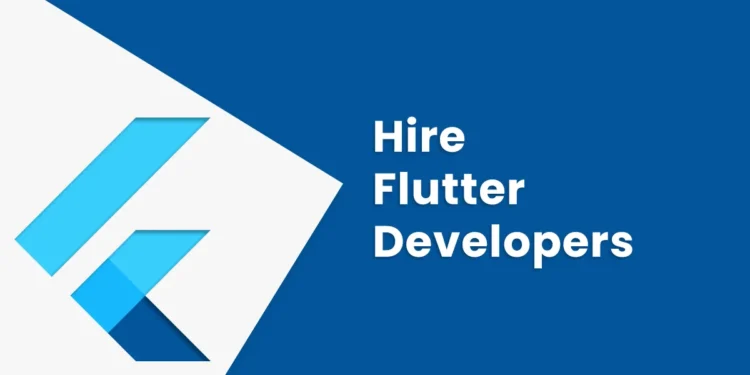In this mobile-first world, there are various ways for businesses to reach both iOS and Android users without duplicating the effort of developing their apps. Google Flutter open-source framework has gained strong momentum in developing cross-platform apps. Developers can write apps in a single code base for both platforms, which saves time and costs and allows performance to be kept consistent across devices. If you’re considering building a mobile app, it’s a great idea to hire Flutter app developers who can leverage the power of this framework to its full potential.
Its set of rich, customizable widgets, fast development cycles, and native-like performance gives it the thumbs-up for startups and enterprises intent on delivering high-quality mobile apps in a fast and effective manner. This article will explain why Flutter is the top choice for cross-platform development.
What is Flutter?
Google developed the free, open-source Flutter framework to let developers construct natively built desktop, web, and mobile apps from a single codebase. In the realm of mobile app development, Flutter is especially well-liked since it allows the same codebase to create apps for iOS and Android, therefore saving both time and money.
Flutter distinguishes itself with regard to UI design. Flutter does not rely on native components for UI rendering, unlike more conventional models. Rather, it draws widgets straight using its rendering engine, therefore giving a great degree of design and performance control over apps.
How Does Flutter Work?
The idea of widgets drives Flutter. Every component of a Flutter app—text, buttons, layout, or otherwise—is a widget. Because of their hierarchical arrangement, which provides developers with total control over an app’s design and layout, these widgets allow for
Flutter takes advantage of the Dart programming language, developed by Google as well. For individuals who speak languages like JavaScript or Java, Dart is simple to learn; it’s also made to be quick and efficient. Unlike previous cross-platform frameworks that depended on a JavaScript bridge, when a developer creates a Flutter app, the Dart code is generated straight into native ARM code, resulting in quicker performance.
Regarding Flutter’s underhood operation, it renders images straight on the screen using the Skia graphics engine. This method removes the need for OEM widgets, therefore enabling Flutter apps to have a uniform appearance and feel on several platforms while preserving outstanding performance.
Why Do Startups and Enterprises Choose Flutter?
Mostly because of its flexibility, performance, and many advantages it offers to mobile and web development, startups and businesses select Flutter for a variety of reasons. These are some main factors explaining its popularity:
1. Cost-Effective Development
Budget is usually a big factor for companies and startups choosing a technology stack. Because developers can have one codebase for both iOS and Android apps, Flutter greatly lowers costs. Businesses can create apps for both platforms using one team instead of assembling distinct teams for every platform. In both development and maintenance, this can save really significant sums of money.
2. Fast Development Cycle
Without restarting the whole program, Flutter’s hot reload function lets developers see changes made in the code right away reflected in the app. For developers, this speed helps them to iterate fast and test several ideas without waiting long. Startups, which often run in hectic circumstances and must release their apps as soon as possible, find Flutter particularly appealing due to this function.
3. High-Quality User Interface
The potential of Flutter to produce gorgeous, native-like user interfaces is much praised. With highly adjustable widgets, its unique rendering engine lets developers create complex and elegant designs. The degree of design control Flutter provides can really help companies that wish to leave a great impression with their apps.
4. Scalability and Performance
Companies seeking long-term answers sometimes require an app that can grow. Flutter is an excellent candidate for large-scale apps because of its native-like performance and handling of challenging app functionality. Flutter builds natively in native code, hence the performance is usually on par with that of completely native apps.
What is Cross-Platform Mobile App Development?
Development of cross-platform mobile apps is the process of creating single-code-based mobile apps capable of running on several operating systems (like iOS and Android). Rather than creating distinct apps for every platform, which calls for various codebases and knowledge, developers create one app that may be used on several platforms.
Cross-platform development offers several advantages, such as reducing development time, cutting costs, and simplifying maintenance. Several frameworks, including Flutter, React Native, and Xamarin, are popular for cross-platform mobile app development. These tools help businesses cater to a larger audience while maintaining a more manageable and cost-effective development process. As part of comprehensive mobile application development services, businesses can leverage these frameworks to optimize their development efforts and enhance the user experience across platforms.
Top Reasons to Choose Flutter for Cross-Platform App Development
Because of its many benefits, choosing Flutter for cross-platform app development has become rather common. These are the main causes behind developers’ and companies’ choice of Flutter for cross-platform app development requirements:
1. One Codebase for Multiple Platforms
Flutter’s key attraction is its one codebase ability to run on both iOS and Android. Companies had to create and maintain two separate codebases for their mobile apps historically, which complicated development and raised expenses. Using Flutter, developers save a lot of time and money by merely keeping one set of code that runs effortlessly across both platforms.
2. Fast Development and Iteration
Developers will find Flutter’s hot reload capability revolutionary. Instantaneous changes made to the code in real-time on the emulator or device allow developers to quickly test new ideas, fix problems, and improve their code with little downtime. When working on tight deadlines or iteratively depending on user feedback, this speeds up the development cycle, which is quite helpful.
3. Native Performance
Many cross-platform systems depend on a bridge between JavaScript and native code, which can occasionally compromise speed. By building straight into native ARM code, Flutter avoids this problem and yields improved performance. For sophisticated business logic or apps with an animation focus, Flutter’s performance is usually exactly like that of a completely native app.
4. Rich Set of Widgets and Customization
Flutter offers a complete range of pre-built widgets with customizing ability to meet the particular requirements of the application. From buttons to menus to whole screens, Flutter’s widget library guarantees that developers can construct apps that seem and feel natural for the platform they are operating on. Furthermore, Flutter lets developers create unique widgets, therefore enabling great degrees of creativity and control over the look of the program.
5. Strong Community and Support
Flutter has attracted a fast-expanding community of developers since its introduction, which has resulted in more tools, guides, and outside libraries. Because of this active ecosystem, developers can usually discover ready-made answers to typical challenges, therefore accelerating and simplifying their work.
Furthermore, since Google supports Flutter, the framework is constantly updated, and there is great continuous support, which guarantees companies that Flutter will always be a powerful and dependable choice in the future.
6. Cost-Effective Maintenance and Updates
Maintaining and updating the app becomes far easier with a unified codebase for iOS and Android. Both platforms can have new features introduced concurrently and bugs corrected so that consumers on iOS and Android experience the same thing. Since two different codebases for updates are not necessary, this lessens the general maintenance load.
7. Large Talent Pool
For developers familiar with languages like Java, JavaScript, or C#, Dart—the programming language used for Flutter—is rather easy to learn. As Dart is growing more and more popular, developers knowledgeable with the language are becoming more frequent, which facilitates the search for suitable developers for businesses.
Conclusion
Because Flutter can save time and money, offer premium user experiences, and run on par with native apps, it has become a favorite choice for cross-platform mobile app development. Looking for a quick, scalable, and reasonably priced approach to create mobile apps, both startups and businesses now turn to it most often.
For companies trying to produce outstanding mobile experiences, Flutter is a fascinating choice because of its main advantages—one codebase for several platforms, rapid development cycles, broad customizing choices, and native performance.
One of the most sensible and effective options for cross-platform mobile app development, Flutter’s popularity is only anticipated to rise with constant Google support, a growing community, and a strong set of capabilities.












